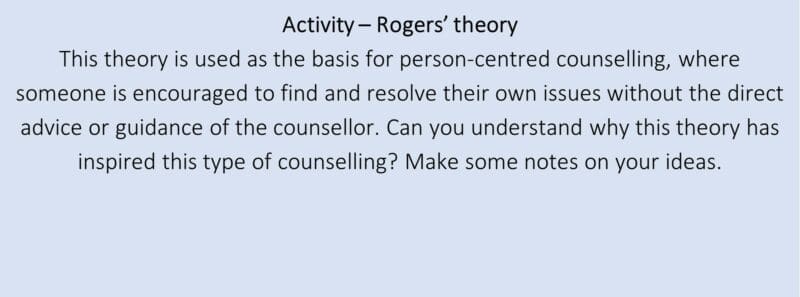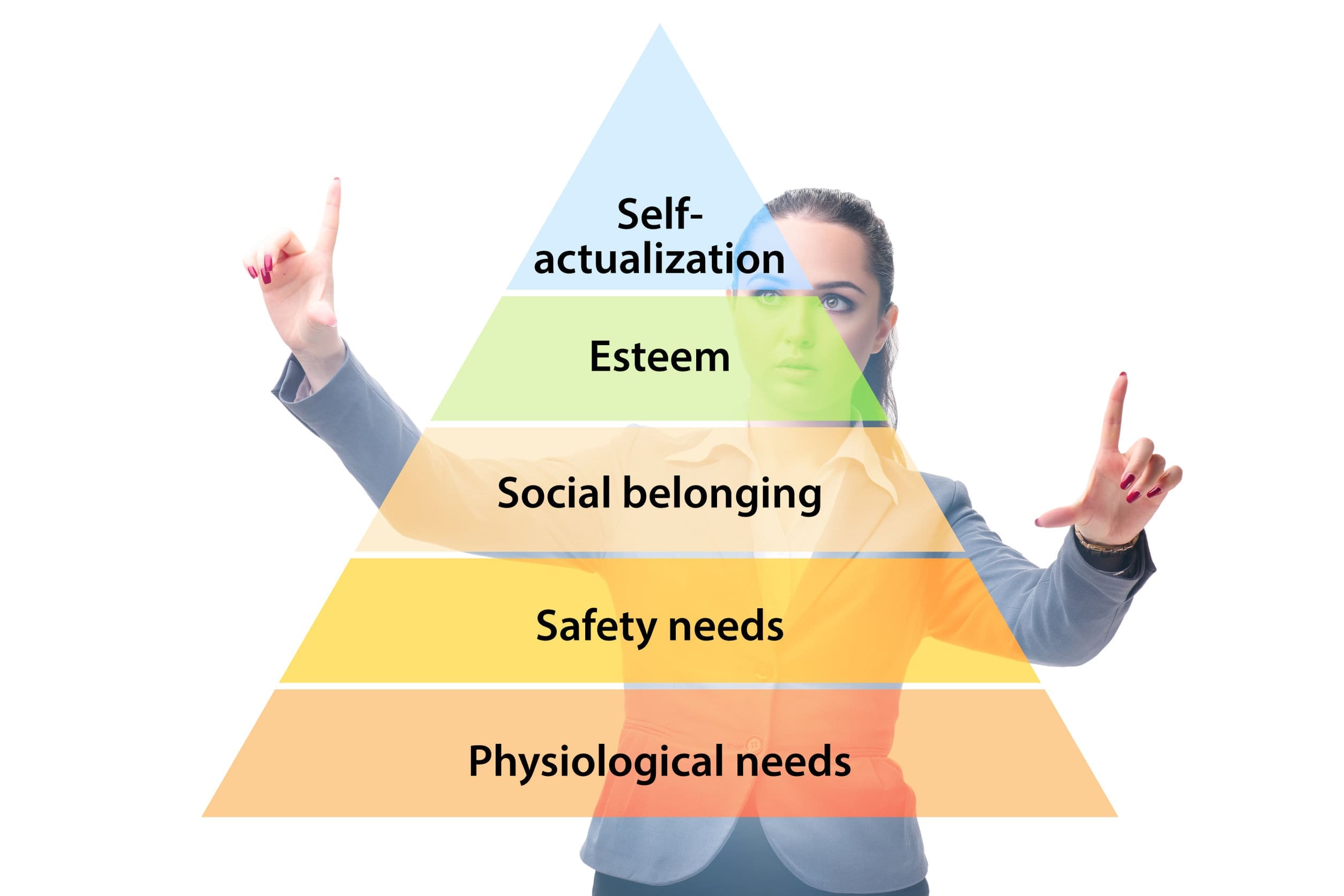In this post
The humanistic approach to psychology explores the individual experiences of people, recognising the fact that everyone experiences their environment in a way that is specific to them. It maintains that people have free will, so that they are able to make changes to their lives and that people are basically good and want to strive to make things better.
The theory is very optimistic and it sees the ultimate aim for humans as being ‘self-actualisation’, which we will look at in more detail later in the section.
Rogers’ theory of the development of self and self-esteem
Rogers’ theory is based around the notion that all humans are good and that they all strive for personal growth in order to be the best person that they can possibly be. In order to be able to achieve this, it is necessary that a person has a positive concept of self and that they have a good level of self-esteem, to promote personal confidence.
Focus on childhood is important to this theory as Rogers argued that this is a time when people develop a sense of self-worth, which comes from the judgment of other people.
Unconditional and conditional positive regard
One of the most important aspects of Rogers’ theory concerns unconditional and conditional positive regard:
- Unconditional positive regard: this comes when a person is valued for who they are no matter what they do and so with no conditions being attached. For example, parents who accept that their children make mistakes but still value them show them unconditional positive regard. This is an excellent way to raise their self-esteem and their self-image
- Conditional positive regard: this means that a person is only valued when certain conditions are met, which causes someone’s self-esteem to be lowered. This can be shown in childhood where parents only seem to love their child when they are well behaved and when all rules are being followed.
Congruence and incongruence
Rogers argued that people will never be able to work towards good self-esteem if they are in a state of incongruence, which means that their self-image and ideal self are not matched. When someone goes for counselling, one of the overarching aims is for someone to amend their self-image so that it is more realistic. This means that they can raise their levels of confidence and self-esteem and one of the ways to work towards congruence (where self-image and the ideal self match) is to explore their conditions of worth.
Conditions of worth
In order for someone to have a positive sense of self-worth, it is important that they are able to develop without conditions of worth, which are placed on them by others. For example, a child may only have been praised when they did well at something, rather than when they tried something but did not succeed. This may make the child only feel valued when they are good at something, which can have a hugely negative impact on their self-esteem and self-worth because they can be led to feel that nothing they ever do is good enough.
To overcome this, it is necessary for people to feel valued no matter what, which can be difficult for adults if they have had conditions of worth placed on them as they were growing up.

Strengths of Rogers’ theory
- This is a very positive theory, giving people hope that they can amend the way that they view themselves and move towards a better state of mind
- Person-centred counselling is very much based on Rogers’ original work and this is now a very commonly used type of therapy to help people who are experiencing all types of mental ill health.
Weaknesses of Rogers’ theory
- It is difficult to determine the success of Rogers’ concepts as they are not scientific and are therefore impossible to measure with any form of accuracy. This means that the findings from studies are less reliable.
Maslow’s hierarchy of needs
Maslow attempted to explain an individual’s personality in terms of their needs, which he placed on a hierarchy in order of what he felt needed to be achieved first before others could be achieved afterwards until all had been achieved and a person was able to self-actualise. (See diagram in earlier part of this section.)
Maslow maintained that a person would not be able to be completely fulfilled until all needs have been met. So, for example, in a counselling situation, if someone explained that they had poor housing and this led them to depression, Maslow would interpret this as their most basic physical need for shelter not being met and therefore they would be unable to move up the hierarchy, which was causing their depression.
Strengths of Maslow’s theory
- Like Rogers, this theory is also positive and encourages people to try and meet their full potential
- The theory is widely accepted in counselling and can be used to help people identify needs which may not be being met and therefore changes can be made once these have been identified.
Weaknesses of Maslow’s theory
- Maslow’s work was mostly carried out in a Western culture, which does not take into account others, where needs may be different and be prioritised differently too
- Maslow himself acknowledged that true self-actualisation was rare and that only a few people in a lifetime would be able to achieve this. This goes against the overall positivity that the theory purveys.
Internal factors on the self and self-esteem
Although self-esteem is very unique to each individual, it is maintained that several consistent factors lead to its development and these can be either internal or external. Internal factors are those that come from within a person and are features of who we are.
Temperament
A person’s temperament is something which is innate to them, so it is biological in nature. It relates to a person’s emotions and the extent to which we are able to control those emotions. It is possible that temperament can affect a person’s self-concept. For example, someone who shows introvert traits such as shyness and lack of social interaction may eventually become isolated and this might lead them to experiencing depression and low self-esteem.
On the other hand, someone who has extrovert traits may well experience depression if others seek to avoid them due to their lack of inhibitions and potentially overbearing nature.
Other aspects of temperament that may affect someone’s self-esteem include:
- Effortful control
- Negative emotions
- Persistence.
Effortful control
When a person can successfully carry out effortful control, they are able to correctly prioritise decisions, ensuring that things are carried out in a way that is most beneficial. For example, a child may choose to walk away from others who are smoking or to do homework when others have gone out. It is argued that children who can self-regulate are better able to interact with others and therefore have higher self-esteem.
Negative emotions
Someone who experiences persistent negative emotions is more likely to experience anxiety, which often leads to low self-esteem and depression.
Persistence
If someone is persistent when attempting to carry out a difficult task, it is argued that they will have higher self-esteem as they are not put off by failure and will continue until they have succeeded. This is good for self-esteem and overall confidence.
External factors on the self and self-esteem
As well as internal factors on the self, there can be external factors which can impact upon a person’s self-esteem. External factors come from a person’s environment, such as situations and experiences.
Self-efficacy and experiences
Self-efficacy refers to how strongly someone believes that they can succeed in certain situations and when carrying out certain tasks. Self-efficacy is not fixed and can vary dependent upon the task. For example, someone may have high self-efficacy that they can do well in an exam but low self-efficacy that they can pass their driving test. It may well be that previous experiences of failure can lead to low self-efficacy and success has led to high self-efficacy. It is therefore very much determined by the situation that someone finds themselves in, clearly highlighting the importance of experience.
Comparison with others
When someone compares themselves with a person who is better at a task than they are, this will likely lead to low self-esteem, as the person may see themselves as a failure. On the other hand, when a person compares themselves with someone who is not as good at something as they are, this can lead to high levels of self-esteem and, consequently, a more positive self-image.
The perception of others
How others perceive us is thought to be crucial to the development of self-esteem. Someone who does well in school will be considered as ‘clever’, which will be beneficial for their confidence. Someone who plays a musical instrument very well might be perceived as ‘talented’, which is also good for self-esteem. Someone who is perceived as not being good at things, will have their self-esteem negatively affected as they will doubt their abilities and may see themselves as unsuccessful.



